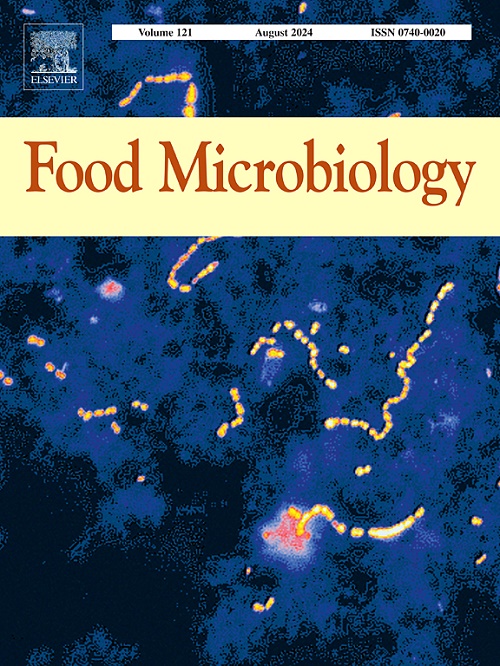探索内源性乳酸菌的潜力:分离到芳香族化合物的遗传见解
IF 4.5
1区 农林科学
Q1 BIOTECHNOLOGY & APPLIED MICROBIOLOGY
引用次数: 0
摘要
本研究旨在探索从巴西圣保罗产的牛奶和奶酪中分离的内源性乳酸菌(LAB)在发酵乳制品制备中的技术潜力。共分离出微生物562株,优势种为鼠李糖乳杆菌和粪肠球菌。对其中169株菌株进行了工艺性质鉴定,并应用主成分分析(PCA)对最有应用前景的菌株进行了排序。在此基础上,对43株菌株进行了酸化潜力、自溶、抗菌活性、抗生素敏感性和芳香族化合物产量的评价。delbrueckii乳杆菌CTR1的酸化潜能最高(ΔpH 1.00)。鼠李糖乳杆菌JLR3对肠炎沙门氏菌和金黄色葡萄球菌具有较强的抑菌活性,粪肠球菌ITR5对大肠杆菌具有较强的抑菌活性。根据发酵乳的芳香化合物特征,选择鼠李糖乳杆菌AQTR10和新疆肠球菌AQLM2进行测序和功能鉴定。这些菌株被证明可以产生二乙酰(丁烷-2,3-二酮),乙酰(3-羟基丁烷-2-酮),乙酸(乙醇酸)和乙醛(乙醇)。功能注释显示,鼠李糖具有通过柠檬酸途径合成双乙酰和乙酰的遗传机制,以及通过醛脱氢酶编码基因产生乙醛和乙酸的遗传机制。在新疆叶蝉中发现了乙醛生物合成的遗传证据。这些发现表明,从巴西东南部乳制品样品中分离出的两种乳酸菌菌株有望作为发酵乳制品开发的辅助培养物。本文章由计算机程序翻译,如有差异,请以英文原文为准。
Exploring endogenous lactic acid bacteria potential: Isolation to genetic insights on aromatic compounds
This study aimed to explore the technological potential of endogenous lactic acid bacteria (LAB) isolated from milk and cheese produced in São Paulo, Brazil, for use in the preparation of fermented dairy products. A total of 562 microorganisms were isolated, with Lacticaseibacillus rhamnosus and Enterococcus faecalis being the predominant species. Among these, 169 isolates were characterized for their technological properties, and Principal Component Analysis (PCA) was applied to rank the most promising strains. Based on this analysis, 43 isolates were selected and evaluated for acidification potential, autolysis, antimicrobial activity, antibiotic susceptibility, and aromatic compound production. Lactobacillus delbrueckii CTR1 exhibited the highest acidification potential (ΔpH 1.00). Lacticaseibacillus rhamnosus JLR3 displayed strong antimicrobial activity, particularly against Salmonella Enteritidis and Staphylococcus aureus, while Enterococcus faecium ITR5 was effective against Escherichia coli. The aromatic compound profile of fermented milks led to the selection of Lacticaseibacillus rhamnosus AQTR10 and Enterococcus xinjiangensis AQLM2 for sequencing and functional characterization. These strains were shown to produce diacetyl (butane-2,3-dione), acetoin (3-hydroxy-butan-2-one), acetic acid (ethanoic acid), and acetaldehyde (ethanal). Functional annotation revealed that L. rhamnosus possesses the genetic machinery for diacetyl and acetoin biosynthesis via the citrate pathway, as well as for acetaldehyde and acetic acid production through an aldehyde dehydrogenase-encoding gene. In E. xinjiangensis, genetic evidence for acetaldehyde biosynthesis was identified. These findings suggest that the two LAB strains isolated from dairy samples in southeastern Brazil hold promise as adjunct cultures for fermented dairy product development.
求助全文
通过发布文献求助,成功后即可免费获取论文全文。
去求助
来源期刊

Food microbiology
工程技术-生物工程与应用微生物
CiteScore
11.30
自引率
3.80%
发文量
179
审稿时长
44 days
期刊介绍:
Food Microbiology publishes original research articles, short communications, review papers, letters, news items and book reviews dealing with all aspects of the microbiology of foods. The editors aim to publish manuscripts of the highest quality which are both relevant and applicable to the broad field covered by the journal. Studies must be novel, have a clear connection to food microbiology, and be of general interest to the international community of food microbiologists. The editors make every effort to ensure rapid and fair reviews, resulting in timely publication of accepted manuscripts.
 求助内容:
求助内容: 应助结果提醒方式:
应助结果提醒方式:


